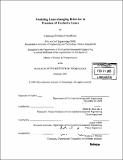| dc.contributor.advisor | Moshe E. Ben-Akiva and Tomer Toledo. | en_US |
| dc.contributor.author | Choudhury, Charisma Farheen, 1978- | en_US |
| dc.contributor.other | Massachusetts Institute of Technology. Dept. of Civil and Environmental Engineering. | en_US |
| dc.date.accessioned | 2005-09-27T19:07:13Z | |
| dc.date.available | 2005-09-27T19:07:13Z | |
| dc.date.copyright | 2005 | en_US |
| dc.date.issued | 2005 | en_US |
| dc.identifier.uri | http://hdl.handle.net/1721.1/28929 | |
| dc.description | Thesis (S.M.)--Massachusetts Institute of Technology, Dept. of Civil and Environmental Engineering, 2005. | en_US |
| dc.description | Includes bibliographical references (p. 119-122). | en_US |
| dc.description.abstract | Driving behavior is significantly affected by the presence of exclusive lanes. Particularly, unlimited access to exclusive lanes result significant amount of special type of lane-changing actions. The objective of this thesis is to develop an improved lane-changing model that has a generalized structure and is flexible enough to capture the lane-changing behavior in all situations including the presence of unlimited access exclusive lanes. A new lane-changing model with explicit choice of target lane is proposed in this regard. The target lane is the lane the driver perceives as the best to be in taking a wide range of factors and goals into account. The direction of the immediate lane change is based on the choice of this target lane rather than myopic evaluation of adjacent lanes. A lane change occurs in the direction implied by the chosen target lane depending upon gap availability. The parameters of the model are jointly estimated with detailed vehicle trajectory data and calibrated for a situation with unlimited access High Occupancy Vehicle (HOV) lane. Estimation results show that the target lane choice is affected by lane-specific attributes, such as average speed and density, variables that relate to the path plan and the interactions of the vehicle with other vehicles surrounding it. The model is validated and compared with an existing lane-changing model using a microscopic traffic simulator in an HOV lane situation. The results indicate that the proposed model is significantly better than the previous model. | en_US |
| dc.description.statementofresponsibility | by Charisma Farheen Choudhury. | en_US |
| dc.format.extent | 122 p. | en_US |
| dc.format.extent | 5489452 bytes | |
| dc.format.extent | 5504638 bytes | |
| dc.format.mimetype | application/pdf | |
| dc.format.mimetype | application/pdf | |
| dc.language.iso | en_US | |
| dc.publisher | Massachusetts Institute of Technology | en_US |
| dc.rights | M.I.T. theses are protected by copyright. They may be viewed from this source for any purpose, but reproduction or distribution in any format is prohibited without written permission. See provided URL for inquiries about permission. | en_US |
| dc.rights.uri | http://dspace.mit.edu/handle/1721.1/7582 | |
| dc.subject | Civil and Environmental Engineering. | en_US |
| dc.title | Modeling lane-changing behavior in presence of exclusive lanes | en_US |
| dc.type | Thesis | en_US |
| dc.description.degree | S.M. | en_US |
| dc.contributor.department | Massachusetts Institute of Technology. Department of Civil and Environmental Engineering | |
| dc.identifier.oclc | 60525144 | en_US |
